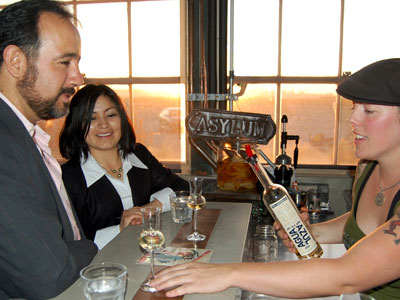
“The spirit of Mexico does not give itself up easily,” says Lance Winters of St. George Spirits in Alameda. “It’s a proud, strong spirit,” he says of tequila and the difficult process to produce a great agave drink. Located on the former U.S. Navy airbase across the water from both downtown Oakland and San Francisco, the innovative distillery has produced the first tequila in the U.S. that is made from cooked agave imported from Mexico. It is also the
only tequila produced in Northern California. Producing the tequila was a great challenge that required permission from both the Mexican and U.S. governments, and a production process that tested both man and machine.Luis Bustamente, tasting room manager at St. George Spirits, went to the Tequila Regulatory Council in Mexico. The council’s biggest concern, says Lance, was that they wouldn’t put the word ‘tequila’ on their label, as other American distillers have tried in the past. Companies in the U.S. can package and sell tequila as ‘tequila’ only if it is produced in Mexico. Lance says that even if he had permission from the Mexican government to call his product tequila, he wouldn’t do it out of respect for the tequila region and tradition in Mexico. Since it was blue agave that they were using for the new tequila, they chose to name it ‘Agua Azul’.
“There are some really fabulous tequilas out there, but we didn’t want to make just another good tequila,” says Lance. “We wanted to make something that gave us a reason for making it – we were really interested in working with the agave and seeing what our spin on the blue agave would be,” he adds.
Working with the agave was a greater challenge than they expected, especially since the distillery uses a process where the agave piña is used in its entirety throughout the fermentation and distillations process.
In Mexico, the agave piña is run through a series of roller mills to extract the juice, which was not an option for the small distillery. As they began to process the 40,000 pounds of cooked agave piñas, it was clear that their equipment was not suited for the job. Machetes were used to reduce the size of the piñas, but progress was still too slow. They then bought chainsaws, which stopped working after three minutes. After trying a hammermill and a commercial tree chipper, the agave was still winning the battle. Finally, a commercial dog food milling machine was able to process the strong piñas. The agave was fermented and then loaded into shiny copper stills for distillation. When distillation was complete, the unaged Blanco was ready to drink. Months later, the Reposado and Añejo versions were ready, resulting in a total of 377 gallons of what Lance calls, “the most amazing rendition of agave spirit I've ever had.”
Lance says that consumer response to their tequila has been favorable from both tequila lovers and tequila beginners. “It has a sweetness and a smoothness that is not typical for most tequilas,” says Lance.
After years of work to import the agave, several weeks of difficult processing, and the destruction of four pieces of equipment, Lance says it was totally worth the effort and he plans to import more agave to produce more tequila. Following their battle with the agave, Lance and his team have a deeper respect for the agave fruit and for the wisdom of tequila making techniques used for centuries in Mexico. Speaking of that battle, Lance says, “To get a bunch of gringos to sweat to make it is a beautiful irony.”

